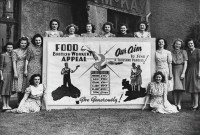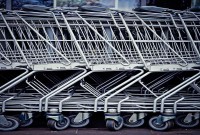- Home
- Business Processes
- Industry Knowledge
- Aerospace Industry
- Automotive Industry
- Banking Domain
- BFSI Industry
- Consumer/ FMCG Industry
- Chemicals Industry
- Engineering & Construction
- Energy Industry
- Education Domain
- Finance Domain
- Hospitality Domain
- Healthcare Industry
- Insurance Domain
- Retail Industry
- Travel and Tourism Domain
- Telecom Industry
- Leadership Skills
- eLearning
- Home
- Domain Knowledge
- Retail Industry
- Retail Industry: Key Performance Metrics
Retail Industry: Key Performance Metrics
You cannot manage what you do not measure and cannot measure what you do not define. Learn the key performance metrics for the retail industry like Sales per square foot, Gross margins return on investment, Average transaction value, Customer retention, Conversion rate, Foot traffic, and digital traffic and Inventory turnover, etc. These metrics are used across the globe by key industry players to track and improve their performance.
Key Metrics in Retail
Every business has its own set of metrics that helps the business to assess its performance and benchmark itself against others in the business. Metrics are, simply, a set of measurements that evaluate retail establishment’s outcomes against some kind of benchmarks, such as past performance, store objectives, and industry averages. Metrics are also called “key performance indicators.”
Defining metrics for measuring the success of a retail business is not easy due to the prevalence of several formats of retail globally such as supermarkets, hypermarkets, single-brand retail, department stores, specialty chains, and many more. Players in the retail industry need to define metrics that are not only relevant for physical customers but also their virtual customers.
The focus here is to describe the few important metrics that are being measured by the retail industry globally. For most retailers, key store metrics include traffic counts, conversion rates, and the performance of sales staff. Given below is an exhaustive list of commonly used retail performance measures:
|
Metrics |
Definition of Metrics |
|
Sales per Square Meter or Profit per Square Meter |
It measures the retail space performance on the basis of sales/profits as per the area of floor space covered. This measure is conducive to use when only a single layer of merchandise is displayed and various types of fixtures are placed. This is a common measure for fashion retailing. |
|
Sales per Linear Meter or Profit per Linear Meter |
It measures retail space productivity on the basis of income generated by footage of the shelf space allocated. This measure is more suitable for stores using multi-shelf fixtures such as racks. It takes into account the linear value of the shelf rather than the area of space exposed in terms of the height value of the shelf. |
|
Sales per Cubic Meter or Profit per Cubic Meter |
It measures retail space performance on the basis of length, width, and depth of the fixtures placed in the stores. This measure is necessarily used by the retailers in the frozen food business or those who place dump bins on the retail floor. |
|
EBITA/Interest |
EBITA, or earnings before interest, taxes, and amortization, divided by interest. This metric provides an interest coverage ratio that identifies a company's ability to pay interest on its debt. |
|
Retained cash flow/Net debt |
Retained cash flow, or the cash flow from operations before working capital changes minus dividends, divided by a company's net debt. This metric provides information about a company's ability to pay its debts. |
|
Free cash flow/Net debt |
Free cash flow, or all cash flows except those from financing activities, divided by a company's net debt. This metric reflects a company's ability to repay its debts. |
|
Cash flows from operations/Gross debt |
Cash flow from operations, (typically the cash flows from operating activities after working capital reported by retailers) divided by a company's gross debt. This metric provides information about a company's ability to repay debt. |
|
Sales/Square footage |
Total sales divided by the square footage. This metric identifies the average sales per square foot of a retail establishment. |
|
Sales/Inventory |
The number of units sold for a product divided by the number of units in inventory. This metric provides a ratio of the inventory available for sale to the actual number of units sold. |
|
Cost of goods sold/Average inventory |
The cost of goods sold divided by the average inventory. This metric provides a measure of inventory turnover. |
|
Product Return |
Measures the value of the products that were sold and returned to the store by the client, for various reasons |
|
Product sold per transaction |
Measures the average number of items from different product lines sold on a per purchase basis. A product line refers to a number of related products that are developed by the same manufacturer |
|
Out of stock product line |
Measures the number of product lines that are not available in the store |
|
Sale value |
Measures the value of a customer bill/purchase, on average, within the store. |
|
Customers per day |
Measures the average number of customers the store manages to attract on a per-day basis |
|
Units sold per customer |
Measures the average number of units sold by the store on a per-customer basis |
|
% of store loyalty |
Measures the percentage of loyal customers, from all store customers. Loyalty should be defined based on several attributes, such as the size of purchases, time spent in-store, and frequency of purchase. |
|
Frequency of store visits |
Measures the number of times a customer visits the store in the period, on |
|
Inventory to sales ratio |
Measures the ratio between the retailer's inventory value and the sales revenue |
|
Time spent in-store |
Measures the length of time spent, on average, in-store by prospective |
|
Employee theft |
Metric to measure theft that has been attributed to theft by employees |
|
Shoplifting |
Measures the value amount of products that were stolen from the store. |
|
Vendor fraud |
Measures the value of fraud generated by the vendors. Vendor fraud can be delivering the wrong amount of inventory on the shipping invoice up to removing small amounts of inventory |
|
Sales per unit area |
Measures the value of sales divided by the retail space, on average per unit area. The unit of area is usually square meters in the metric system or square feet in U.S. customary units. |
|
Percentage of selling space |
Measures the percentage of storage space available for selling products, from overall store space |
|
Top-selling items |
Measures the percentage of sales from the top-selling items from gross sales. |
|
Percentage of sales by |
Measures the percentage of sales generated by a product category from the overall gross sale |
|
Sales compared to budget/target |
Actual sales divided by budget/target sales. |
|
Sales compared to last year (or any other period) |
Actual sales for a given period divided by actual sales for the period you want to compare to. |
|
Sales per Square Foot |
Actual sales $ for a given period (usually a month or a year) divided by the total floor area (in sq.ft.) of the store. There are variants of this indicator in terms of sales per square foot of the merchandisable area of choice (like walls and display units.). |
|
Wage Cost |
The actual wage paid for a given period divided by actual sales achieved for the same period. |
|
SGA |
SGA means the costs associated with traditional selling, general and administrative functions. |
Other Key Metrics in Retail:
Given below are some other metrics that can also be useful based on the reporting needs:
Demographic Metrics:
- Total sales
- Three-year revenue CAGR
- Employees
- End-users
- Domestic sales as % of total sales
- Gross margin %
- Number of retail banners
- Number of stores
- Average square footage per store
Baseline Metrics:
- Total SGA cost distribution by cost component
- Total SGA cost distribution by function
- Total SGA staff distribution by function
Metrics for Executive Summary:
- Total SGA cost as a percent of sales by function
- Total SGA cost gap to low-cost performer by function
- Cost as a percent of total SGA cost
- Total process cost as a percent of sales
Metrics Tracking Store Operations:
- Store operations cost as a % of sales (labor, outsourcing, technology, other)
- Store operations cost allocation (labor, outsourcing, technology, other)
- Store management cost allocation
- Process category cost as % of sales
- Store operations process category cost allocation
- Total store operations FTEs per $1B in revenue
- Store operations fully loaded labor rate
- Store operations total cost per store operations staff
- Store operations total cost per store
- Occupancy cost per store
- Store operations process cost per store
- Sales per sq ft selling space
- Store operations cost per sq ft selling space
- Sales per labor hour (SPLH)
- Store associate turnover %
- Inventory shrink %
- Total shopper returns as % of total sales
- Loss prevention process cost as a percent of sales
Metrics Tracking Merchandising:
- Merchandising cost as a % of sales (labor, outsourcing, technology, other)
- Merchandising cost allocation (labor, outsourcing, technology, other)
- Process category cost as % of sales
- Merchandising process category cost allocation
- Total merchandising FTEs per $1B in revenue
- Merchandising fully loaded labor rate
- Sales per buyer
- The average number of SKUs managed per buyer
- Number of active vendors
- Number of purchase orders generated
- % of goods sourced domestically
- Private label sales as % of total sales
- % direct sales (online, catalog, phone) as % of total sales
- % of sales promoted
- % sales on markdown
Metrics around Supply Chain Function:
- Supply chain cost as a % of sales (labor, outsourcing, technology, other)
- Supply chain cost allocation (labor, outsourcing, technology, other)
- Process category cost as % of sales
- Supply chain process category cost allocation
- Total supply chain FTEs per $1B in revenue
- Supply chain fully loaded labor rate
- Inventory turns
- Cartons picked per labor hour (pick function only)
- % of merchandise returns to the warehouse
- Vendor compliance offset $ as % of total revenue
- Transportation cost per inbound carton
- Transportation cost per outbound carton
- Import order cycle time days
- Import shipments routed via airfreight as % of total shipments
Importance of Metrics in Retail
Essentially, metrics turn data generated by the store into intelligence. By measuring the success of these parts of the operation, retailers can understand what works and what doesn’t work, set realistic targets, and gauge the store’s performance against past performance, the store’s goals, and the rest of the industry. Sales and profitability are considered established measures of retail unit success. They can be used to measure the performance of retail space management. The measures of retail space performance indicate the productivity of retail space.
Technology and the right business processes offer a way to draw intelligence from the data more easily. With the right technology and processes in place, retailers can pull more precise and more useful details from the raw data. Retailers who can generate intelligence about customer preferences and buying patterns are better able to connect with individual customers, refine the product mix, and hone customer service and business practices to be more efficient, cost-effective, and responsive. The more refined the data, the more precise the retailer can measure the store’s current performance against past performance, market performance, and retail industry benchmarks.
Related Links
You May Also Like
-
Challenges in Consumer Goods Industry
There are tens of thousands of general consumer products manufacturers in the United States. They compete to develop the best products at the most affordable price for the greatest number of consumers. Challenges for these organizations include meeting the changing demands of customers, maneuvering through a consolidating market, and executing strategies to grow profitably.
-
Durable goods are consumer goods that have a long life span (e.g. 3+ years) and are used over time. Highly durable goods such as refrigerators, cars, or mobile phones usually continue to be useful for three or more years of use, and hence durable goods are typically characterized by long periods between successive purchases.
-
Retail Industry: Current Challenges
Today consumers are choosing multichannel buying experiences and expect that to be a seamless experience. To attract customer loyalty, retailers need to provide an experience that stands out from others. Learn the challenges faced by the retail sector today. Multi-channel sale avenues, changing consumer behavior, technological advances, rising competition, rising frauds, and supply chain management are some of them that require immediate attention.
-
Retail Industry: Revenue Model
Understand the traditional retail revenue model and, what are the variations in different revenue models adopted by key players in the retail industry. Analyze the pros and cons of various models. The most common and most profitable revenue model is that of the traditional retailer. The traditional retailer profits by selling products and services directly to buyers at a mark-up from the actual cost.
-
Retail Industry Sectors: Types of Retail
A marketplace is a location where goods and services are exchanged. The traditional market square is a city square where traders set up stalls and buyers browse the merchandise. Now retail goods are generally sold in a number of different establishments. Convenience Stores, specialty stores, department stores, supermarkets & hypermarkets, discount stores, multichannel stores are some models used by the retail industry to provide goods to end customers.
-
Markets are continuously changing and to understand the dynamics of any industry it is important to understand what is happening and how the industry market players see the future for the industry. In this article, we will discuss the recent trends witnessed by the retail sector. This document provides insights into major trends identified for the retail sector.
-
Retailing is the combination of activities involved in selling or renting consumer goods and services directly to ultimate consumers for their personal or household use. In addition to selling, retailing includes such diverse activities as, buying, advertising, data processing, and maintaining inventory. This article explains the meaning of retail and its etymology. Understand the meaning and constituents of the retail industry and the role it plays in the economy of any nation.
-
Competitive Landscape of Retail Industry
In an increasingly competitive landscape, retail industry players must compete in a number of ways. In this article, we will learn about the competitive landscape of the retail industry. Learn the key players in the retail industry and their business profile. Learn more about the top 5 industry players. Competition is rough, especially for the small business. Knowing how business stacks up to the competition is important to your business strategy.
-
Retail Industry: Strategies for overcoming challenges
To stay competitive in this ever-evolving landscape, it is imperative for retailers to deliver a seamless customer experience and provide the right services and products at the right time. Learn the strategies for overcoming challenges for the retail industry. Retailers must use technology and solutions to revive their businesses in the COVID-19 world. An omnichannel marketing strategy can help retailers reach a wider audience for their brands.
-
Retail Industry - Business Model
A retail business model articulates how a retailer creates value for its customers and appropriates value from the markets. In retail, a business model would dictate the product and/or services offered by the retailer, the pricing policy that he adopts. Many different types of retail establishments exist, and, the overall industry has seen a significant blurring of the boundaries that separated the wide range of retail businesses. Understand the key business models adopted by the retail industry. Understand the distinctive ways that retail industry players use to reach to the end consumer.
Explore Our Free Training Articles or
Sign Up to Start With Our eLearning Courses

About Us
Learning
© 2023 TechnoFunc, All Rights Reserved









